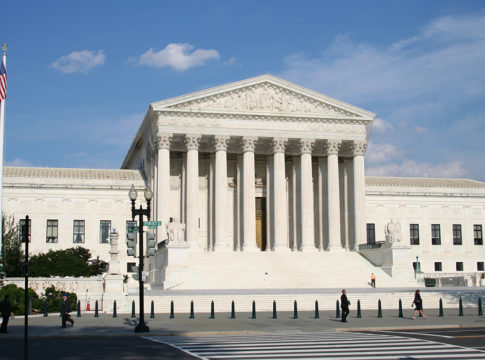Closing the academic achievement gap between white students and disadvantaged minorities has been repeatedly called the “civil rights issue of our time.” Yet unlike the civil rights movement of the 1950’s and 1960’s, in which the judiciary was at the forefront of the fight against inequality, the courts’ role in today’s education reform movement has been quite limited. But a class-action lawsuit out of California, which has pitted the American Civil Liberties Union against the Los Angeles teachers’ union, could inspire a new wave of litigation to improve this country’s troubled schools.
Failing schools may not only diminish the life prospects of young people, but also violate their constitutional rights. While the U.S. Supreme Court has held that education is not a “fundamental interest” under the federal constitution, most state constitutions promise children access to an adequate education. And these constitutional provisions – which most courts interpret as creating a right to instruction that equips students to compete in the global economy – could provide a means for families in substandard schools to demand reform.
In a blow to the local teachers’ union, last January a California Superior Court judge in Reed v. State of California approved a class-action settlement that halted “last hired, first fired” layoffs in up to 45 Los Angeles schools. Parents, on behalf of their children at three largely Hispanic and African-American schools, had sued the district, arguing that these layoffs created an unstable learning environment, and thereby violated students’ constitutional right to “equal and adequate educational opportunity.”
Research shows that reverse-seniority layoffs, which are a hallmark of collective-bargaining agreements and union-backed laws in many states, hit inner-city schools the hardest. Because less experienced teachers tend to aggregate in high-poverty schools, these schools are more prone to layoffs during cutbacks. In turn, the instability associated with high rates of teacher turnover falls disproportionately on poor students. Such was the case in Reed where between 51% and 72% of teachers at the plaintiffs’ schools were pink-slipped before the 2009-10 academic year. Dedicated teachers, many of whom were recruited specifically for their interest in educating underprivileged children, were replaced by rotating groups of short-term substitutes who were often not licensed for their assigned classes. And teachers called off the rehire list were frequently not motivated to work in impoverished neighborhoods, leading many to quit after only a few days.
The Los Angeles Unified School District agreed to a settlement that halted seniority-based layoffs at dozens of vulnerable schools, including the plaintiffs’. The local teachers’ union, United Teachers Los Angeles, which the court had ordered to join the suit as a co-defendant, rejected this resolution as a violation of the union contract. But the court wrote, in its approval of the settlement, that “[u]nder no circumstances can [the school district] bargain away students’ constitutional rights.” In mid-August, the union filed an appeal.
Especially when compared to comprehensive reforms that some state legislatures have recently enacted, the immediate gains from Reed may seem too limited and localized to warrant much attention. After all, Los Angeles is merely one city and help only reached 45 of the district’s nearly 800 traditional public schools. Moreover, the protection offered to these struggling schools came at the cost of more “last in, first out” layoffs in other schools.
However, some legal academics have predicted that Reed will have sweeping, national effects – one calling the case “a shifting of the tectonic plates.” The decision has already influenced other California school districts, including San Francisco and Sacramento, to stop blindly laying off teachers – and the lawsuit could be a model for more ambitious legal action in other states. Besides challenging seniority-based layoffs, the shortage of experienced math and science teachers in inner-city districts – a problem that single salary schedules make worse – could inspire a lawsuit. Plaintiffs could also contest the quality of instruction available in their schools generally. Such a lawsuit could pressure districts to make efforts to attract and retain talented pedagogues as well as to dismantle excessive protections that can make it prohibitively expensive to fire tenured, yet ineffective teachers.
But others expect Reed’s influence to be narrower. “The impact on other states is likely to be quite limited by the fact-oriented nature of the case,” said Michael Rebell, executive director of the Campaign for Educational Equity at Columbia University’s Teachers College and author of “Courts and Kids: Pursuing Educational Equity through the State Courts.” He explained that, in Reed, “the impact of the layoffs was overwhelming – more than half of the teachers at these schools lost their jobs – and so the plaintiffs’ case could be very strongly made.” Though Rebell doubts whether the factual basis for a similar lawsuit could be as compelling in other districts, he found it “interesting and surprising” that the case came out of California, given that its constitutional protections in education have often proved weaker than other states.
Mark Rosenbaum, a law professor at the University of Michigan who worked on the case as chief counsel of the ACLU of Southern California, foresees Reed-inspired cases coming down the pike. “Reed is a reminder that collective-bargaining agreements have to yield to the constitutional rights of children,” he said. In fact, Rosenbaum noted that he was contacted by a number of intrigued school-board members, lawyers, and parents after the settlement was approved.
State constitutional provisions guaranteeing an adequate education are not a novel basis for litigation, but other cases have largely focused on deficiencies in school financing. Beginning in the late 1980’s, civil rights lawyers challenged the constitutionality of several state school systems, arguing that some schools were too underfunded to be adequate. Those cases often resulted in court orders requiring states to provide additional funding to poor schools.
Al Lindseth, an expert in school finance law and coauthor of “Schoolhouses, Courthouses, and Statehouses,” has sharply criticized these judicial remedies on the ground that they only throw money at broken systems. Further, he has argued that, by hearing these cases in the first place, state courts usurp the legislature’s policymaking role and interfere with political issues that are not suited for judicial fact-finding.
Lindseth still contends that “adequacy” cases do not belong in court, but he considers Reed more justifiable than school-finance lawsuits. Reed, he wrote in an email, marks the first time that a court “has addressed an underlying problem in the education delivery structure – the teacher transfer provisions of the union contract – as opposed to leaving in place the underlying problem and instead ordering more money in the hope that increased spending will make up for the inefficiencies caused by the underlying problem itself.”
Reed is also less troublesome to Lindseth to the extent that the court’s decision was based on students’ equal protection rights under the state constitution rather than on the guarantee of an adequate education. In fact, the plaintiffs made both adequacy and equal protection arguments, and the judge did not spell out which legal basis drove his decision. Columbia professor Rebell insisted that the judge recognized students’ right to an adequate education, while Rosenbaum of the ACLU stated that a “hybrid” of equity and adequacy concerns seemed to propel the judge’s reasoning.
These statements followed another recent California Superior Court’s holding that dismissed entirely the notion that students are entitled to an adequate education under the state’s constitution. Just as well for Lindseth, who argues that adequacy provisions – which use inexact words like “adequate,” “suitable,” or “thorough and efficient” to set standards for state schools – are “hopelessly vague” and should not be “an invitation for a court to order more spending or, for that matter, to change provisions in collective bargaining agreements.”
Rightly or wrongly, most courts have assumed jurisdiction over adequacy cases, and judges may be even more likely to do so in non-school finance cases where concerns about infringing on the legislature’s appropriations power are absent. Thus, Reed-inspired plaintiffs outside of the Golden State seem likely to have their day in court. Rebell maintains that families of schoolchildren should be afforded this right. “Without the active involvement of the courts, the national goal of closing the achievement gap will never be achieved,” said Rebell, who favors a collaborative effort between the judicial, executive and legislative branches to solve education problems. “The legislature cannot be expected to act in a principled way without judicial oversight.”
One benefit of pursuing education reform through the judiciary is that the power of special interest groups – namely, the teachers’ unions – is drastically diminished in courtrooms, where political lobbying and campaign contributions are far less influential. Yet Lindseth argues that the autocratic nature of the courts, which are generally less accountable to voters, is one of the chief reasons to reserve education policy matters for the elective branches of government.
However, the courts provide an attractive alternative when the political process fails. “I think we have demonstrated that the executive and legislative branches are not going to be responsive to kids,” said ACLU attorney Rosenbaum. “They do not come through when they are elected into office.” He recounted his participation on Governor Arnold Schwarzenegger’s Committee On Education Excellence, which included a diverse array of education experts, among them economist Eric Hanushek, who were tasked with recommending steps to improve California’s public schools. Despite two years of work that culminated in a 278-page report, none of the group’s proposals were adopted.
If Rosenbaum’s experience is foretelling, lawsuits like Reed may provide a more productive avenue for education reform in states where elected officials disappoint.
Mark Osmond, who holds a master’s degree in economics and public policy from Columbia University, is a law student at the University of Michigan. He can be reached at mark.a.osmond@gmail.com.




